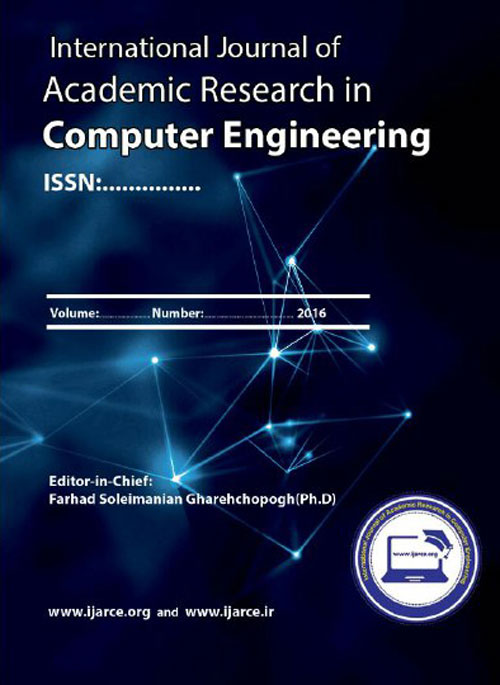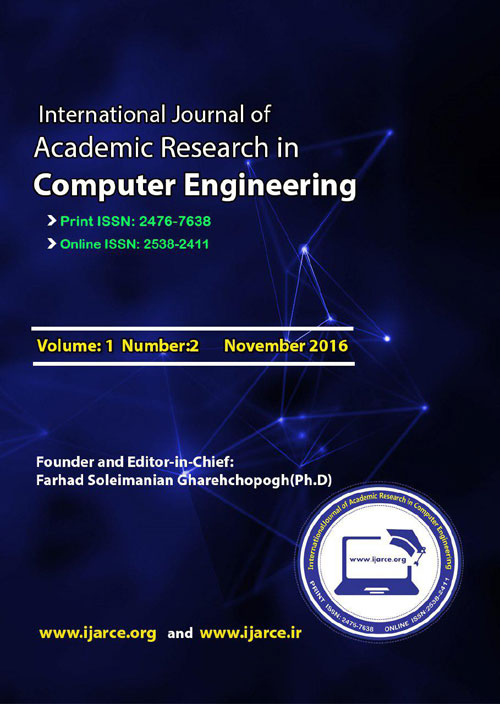فهرست مطالب

International Journal of Academic Research in Computer Engineering
Volume:1 Issue: 1, Sep 2016
- تاریخ انتشار: 1395/06/20
- تعداد عناوین: 8
-
Pages 1-11In software development and software project management, Software Cost Estimation (SCE) will be considered a major step in the start of projects. SCE is one of the main activities at the decisions of software's time and expense management which has a special status in a software project. SCE in software development is considered as a key parameter in software project management. Therefore, to achieve the basic goals requires accurate and reliable cost estimate. Actual estimate in software development is based on effective factors that its accurate value should be recognized using algorithmic models and Artificial Intelligence (AI). Boehm used COCOMO model for SCE which is an algorithmic model in 1981. Algorithmic models such as COCOMO are based on criteria such as the number of lines of code or the Function Point (FP). In COCOMO model, project development and then the cost is calculated by such units. Therefore, the lower accuracy and unreliability of the algorithmic models creates a substantial risk in software projects, so, regularly estimating the cost throughout the project is necessary and it should be compared with other techniques. In the meantime, meta-heuristic algorithms in recent years have made ??good progress in the area of ??software and it has been used widely in SCE. Among meta-heuristic algorithms, Particle Swarm Optimization (PSO), Differential Evolution (DE), Artificial Bee Colony (ABC), and Ant Colony Optimization (ACO) used to optimize the issues based on population and they have good effects in optimizing estimation factors. In this paper, a hybrid model DE-ACO, PSO-ACO and ABC-ACO based on ACO algorithm have been proposed for optimization based on effective factors in COCOMO model. Test results show that hybrid models have less magnitude of relative error (MRE) and Mean MRE (MMRE) in estimating software project cost in comparison with COCOMO model.Keywords: Software Cost Estimation, COCOMO, Meta, Heuristic Algorithms, Optimization
-
Pages 12-16In real time systems, the accuracy of the system's behavior depends on the results of calculations and generated time. One of the biggest challenges of these systems is tasks scheduling according to their deadline. Scheduling issues have complex and sometimes inconsistent conditions, as a result, the system must correctly respond the intended answer within the specific deadline. Industrial control systems, medical, controlled rockets, satellites and so on are of this category. An optimum allocation of tasks in real time multiprocessor systems, often referred to non-deterministic polynomial hard problem. Intelligent methods are used to solve such problems. Data collection in this paper consists of three categories and it is composed of 100 tasks that is implemented in Java language in Eclipse environment. In this paper, the tasks scheduling of real time multiprocessor systems in real time using multi-purpose genetic algorithms for doing tasks and deadlines was studied that this algorithm is optimized to the uniform rate scheduling algorithms.Keywords: Genetic Algorithm, Scheduling Tasks, Real time System, Deadline
-
Pages 17-25One of the most important steps in software testing is automatic test-data generation. The decrease of the number of testing data in addition to the decrease of its generation time (duration), are the main problems in software testing. In this paper, Cuckoo Optimization Algorithm (COA) has been used as one of evolutionary algorithm to increase the path coverage and decrease of generation time of automatic data. The average of likelihood, close to boundary value, and branch coverage for fitness function of COA has been defined. The case studies of this paper are triangle classification, exchange sort, binary search and merge. The proposed model as compared with the method in which the Genetic Algorithm (GA) has been used, is accompanied with the increase of path coverage and the decrease of the execution time in all four case studies. On account of implementation, software triangle has been applied in this paper and in order to acknowledge the authenticity of path coverage (that are the result of executions), petri net simulator has been used.Keywords: Test Data, Cuckoo Optimization Algorithm, Control Flow Graph, Colored Petri Net
-
Pages 26-31Over the past 30 years, one of the challenges of software engineers and managers of software companies in the development of software projects is to estimate accurate cost, effort, quality and risk analysis. Although over 30 years several models presented by researchers, each of them had their strengths and weaknesses. But the need for new methods to overcome the COCOMO model still exists. During the last 20 years models based on Artificial Intelligence have been considered more than other models by researchers which among them, neuro-fuzzy models are the latest model. The aim of this paper is to reduce errors and increase accuracy in estimating the cost and effort in software development. To achieve these goals NASA63 data collection and Adaptive Neuro Fuzzy Inference System (ANFIS) models are used and we could achieve MMRE error in proposed method to 0/0984 and the accuracy of estimate to 0/889.Keywords: Software Cost Estimation, Neuro, Fuzzy Model, COCOMO Model
-
Pages 32-38Nowadays, Software Cost Estimation (SCE) with high precision has been one of the challenging main complex issues for software companies and their executives in software engineering. In the past several decades, the use of Artificial Neural Network (ANN) models in this field has been more efficient compared to traditional techniques which are based on algorithmic methods. ANN models which work on the basis of the data obtained from the previous projects have the advantage of increasing the accuracy of estimation when faced with similar projects during the steps of software life cycle. In this article, we have used perceptron which is a multilayer perceptron (MLP) ANN model for better estimation; in order to optimize this model, we have utilized a strong method called Genetic Algorithm (GA) and the simulation results indicate that the proposed model is more optimal than Algorithmic COCOMOII and MLP ANN models.Keywords: Software Cost Estimation, Multilayer Perceptron Artificial Neural Network, Genetic Algorithm
-
Pages 39-44In most cases, classification has been proposed as an effective method in decision-making. Although countless methods of classification have been stated by the researchers, none of these methods has the same performance and sufficient accuracy for various issues. Accordingly, a hybrid approach has been proposed for classification in this paper. Also, considering the fact that one of the most common accidents all around the world is road accidents and traffic accidents, which endangers the lives of many people annually, therefore, determining the characteristics affecting the type of the accident is very important. Therefore, the information collected by the transportation and terminal organization in Western Azerbaijan province (Iran) were used as data collection in this paper and the aim of it is the accident classification based on the type of accident (damage, injury, death). For this purpose, a new method has been proposed for classification based on the use of two algorithms of Differential Evolution (DE) algorithm and MLP ANN. In the proposed method, DE algorithm is used for extraction of affecting features of classification, and MLP ANN algorithm is used to classify information based on characteristics determined by DE algorithm. The results of the proposed method have been evaluated with evaluation criteria Recall, Precision, F-Measure, and Kappa which the results show that the proposed method is optimal.Keywords: DE Algorithm, MLP ANN, Car Accidents, Classification
-
Pages 45-52Several software projects are developed and produced in software companies annually. Rapid environmental and technological changes, cost constraints, mismanagement, lack of skills of the project managers and inaccurate estimation cause many of these projects to fail in practice. In large software projects, software cost estimation has always been one of the main problems for the project manager and project-development team. The main SCE criterion is to determine the effort required to complete the project. The effort needed is usually determined according to people / month. There is a direct relationship between the amount of effort and the time required to complete a project. And the time can be used to estimate costs. Therefore, the main step in SCE is determining the amount of effort required to complete projects. COCOMO model is the algorithmic model for SCE. In COCOMO model, the emphasis is on the effort coefficients for better performance. In order to measure the relationship between the effort and time, i.e., the relation between the number of code lines and effort coefficients, COCOMO uses some linear formula that utilizes data from NASA software projects. In this paper, we have used bat algorithm to accurately estimate the effort coefficients and to reduce MMRE. Evaluation has been conducted on NASA60 dataset; the results show that BA has much less error compared with COCOMO model.Keywords: software cost estimation, COCOMO model, bat algorithm, NASA60 dataset
-
Pages 53-59In recent years, liver diseases have increased to a great extent in a way that it has turned into one of the most fatal diseases in the world. On time diagnosis of this disease can be effective in the prevention of its bad effects, its control and remedy. With technology advancement and changing many issues in software industry, doctors have developed a tendency towards intelligent systems for better diagnosis. Thus, in this paper, we have diagnosed liver sickness using fuzzy logic by obtaining important laboratory parameters. We have used two types of triangular membership function and Gussy membership function per 3 membership function for each input and output and also the design of reference table (search) to construct fuzzy heuristic system and we have managed to compare 243 rules. At the end, we were able to reach to 79/83% of accuracy with the appropriate choice of input parameters, the number and type of membership functions.Keywords: Liver Sickness, Fuzzy logic, Reference Table, Fuzzy Heuristic System, Membership Function


